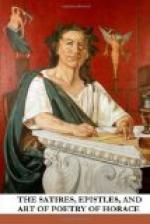Without however enlarging further on the peculiar difficulty of the task, I will proceed to say a few words on some of the special questions which a translator of the Satires and Epistles has to encounter, and the way in which, as it appears to me, he may best deal with them. These questions, I need hardly say, mainly resolve themselves into the metre and the style. With regard to the metre, I have myself but little doubt that the measure in which Horace may best be represented is the heroic as I suppose we must call it, of ten syllables. The one competing measure of course is the Hudibrastic octosyllabic. This latter metre is not without considerable authority in its favour. Two translators, Smart and Boscawen, have rendered the whole, or nearly the whole of these poems in that and no other way: Francis occasionally adopts it, though he generally uses the longer measure: Swift and Pope, as every one knows, employ it in three or four of their imitations: Cowper, in his original poems perhaps the greatest master we have of the Horatian style, translates the only two satires he has attempted in the shorter form: Mr. Martin uses it as often as he uses the heroic: perhaps Mr. Howes is the only translator since Creech who employs the heroic throughout. Some of my readers may possibly wonder why I in particular, having rendered the AEneid in a measure which, whatever its vivacity, may be thought deficient in dignity, should turn round and repudiate it in a case where vivacity, not dignity, happens to be the point desired. I can only say that it is precisely the colloquial nature of the metre which makes me stand in doubt of it for my present purpose. Using it in the case of Virgil, I was sure to be reminded of the need of guarding against its abuse: using it in the case of Horace, I should be constantly in danger of regarding the abuse as the law of the measure.




